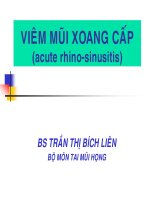Kháng sinh trong viêm phổi , ĐH Y DƯỢC TP HCM
Bạn đang xem bản rút gọn của tài liệu. Xem và tải ngay bản đầy đủ của tài liệu tại đây (2.8 MB, 53 trang )
ANTIBIOTIC FOR
PNEUMONIA
PGS.TS.BS PHAN HUU NGUYET DIEM
Definition of Antibiotics
An Antibiotic is a compound or substance that
kills or slows down the growth of bacteria.
Accordingly, many antibacterial compounds are
classified on the basis of chemical/biosynthetic
origin into natural, semisynthetic, and
synthetic. Another classification system is
based on biological activity:bactericidal agents
kill bacteria, and bacteriostatic agents slow
down or stall bacterial growth.
Classification of Antibiotics
Mechanism of Action
Inhibitors of Cell Wall Synthesis
Beta Lactam Antibiotics
Penicillins
Cephalosporins
Carbapenems
Monobactams
Penicillines
a group of antibiotics derived from Penicillium
fungi.
Inhibits bacterial cell wall synthesis by
binding and inactivating proteins (penicillin
binding proteins) present in the bacterial cell
wall.
Poor CSF penetration, but can occur if there is
menengial inflammation.
Renal excretion
Side effects: hypersensitivity, nephritis,
neruotoxicity, platelet dysfunction
Penicillines
Penicillin G, Penicillin V, Procain PNC, Extencilline
Gram positive cocci & rods
•
•
•
•
•
Gram positive anaerobes
•
•
•
•
Streptococcus Grp A & B
Streptococcus viridans
Enterococcus
Listeria monocytogenes
Actinomyces
Peptostreptococcus
Clostridium tetani
Clostridium perfringens
Clostridium botulinum
Gram negative cocci
• Neisseria meningitidis
• Pasteurella multocida
Spirochetes
• Treponema pallidum
• Leptospirosis
Penicillines
Antipseudomonal Penicillins
Carbenicillin
Ticarcillin +/- clavulanate
Piperacillin +/- tazobactam
Gram (-) enteric rods:
• Enterobacter species
• E.coli
• Proteus
Other Gr (-) bacilli:
• H.influenza
• Pseudomonas aeruginosa
Aminopenicillins
Amoxicillin +/- clavulanate
Ampicillin +/- sulbactam
Gram (+) bacilli:
• Listeria monocytogenes
Gram (-) enteric rods:
• E.coli
• Proteus
• Salmonella typhi
Other Gram (-) bacilli:
• H.influenza
Antistaphylococcal Penicillins
Methicillin
Nafcillin
Oxacillin
Dicloxacillin
Cephalosporins
Structurally similar to penicillins
Resistant to Penicillinases
Therapeutic concentration in many
tissues.
Renal Excretion
Side Effects: hypersensitivity
C1
C2
C3
C4
Antibiotics
Cephalexine
Cephalothin
Cephazoline
Cephadroxii
Cefuroxime
Cefamandol
Cefoxitine
Cefotetan
Cefaclor
Cefotaxime
Ceftriaxone
Cefixime
Ceftazidime
Cefepime
Cefpirome
Spetrum
Cooci Gr (+) Bacille Gr(-) Bacille Gr(-) Gr (-) multiresistances
Pneumo
Cooci Gr (+) Pseudo
Bacille Gr(-)
CSF
(-)
Gr (+) < C1
(-)
(+)
(+)
Monobactams
Aztreonam
Monocyclic beta-lactam ring & relatively resistant to
most beta-lactamases
active against aerobic Gram negative rods, P.
aeruginosa, , but have no activity against gram
positive bacteria or anaerobes.
Penetrates well into the CSF
Not absorbed orally
Side effects: GI, occasional skin rashes
no cross-reactivity with PCNs
Carbapenems
Meropenem/Imipenem
broad spectrum
active against MRSA
given IV
penetrates CSF
renal metabolism and excretion
addition of cilastin (Imipenem - inhibitor of
dehydropeptidase I )
Side effects: GI upset, eosinophilia, neutropenia,
lowering of seizure threshold
Vancomycin
Glycopeptide
Inhibits cell wall synthesis by inhibiting
peptidoglycan synthetase
Most gram-positive bacteria, MRSA
Useful for beta lactam resistant infections
Synergistic action with aminoglycosides against
susceptible gram positives
Slow CSF penetration unless there is meningeal
inflammation
Side effects: Hypotension & “Red Man
Syndrome” if given i.v. in less than 1 hour,
nephrotoxicity, ototoxicity…
Cell Membrane Active Agents
Polymyxins
o A group of basic peptides active against
gram-negative bacteria.
• Serious infections caused by P. aeruginosa, H.
influenzae, E. coli, A. aerogenes & K. pneumoniae
when other drugs are contraindicated
• Ocular infections (bacterial conjunctivitis ophthalmic drops)
• Meningitis
o Side Effects: Nephrotoxic & Neurotoxic
Protein Synthesis Inhibitors
Tetracyclines
Aminoglycosides
Amikacin
Gentamycin
Neomycin
Streptomycin
Tobramycin
Macrolides
Tetracycline
Doxycycline
Minocycline
Azithromycin
Clarithromycin
Erythromycin
Chloramphenicol
Clindamycin
Tetracyclines
Bind to 30S ribosomal subunit.
Broad spectrum bacteriostatic & generally 2nd line drugs
of choice.
Susceptible bacteria include: Streptococcal pneumoniae,
Bacillus anthracis, Clostridium tetani, Brucella,
Helicobacter pylori, Actinomyces, Rickettsia, Chlamydia
and Mycoplasma.
Doxycycline: Malaria prophylaxis, Bacillus anthracis
Minocycline: Acne
Not recommended for pregnant women, infants and
children 8 years or younger.
Side Effects: Staining of teeth, retardation of bone
growth, GI toxicity, Photosensitivity…
Aminoglycosides
Streptomycin
Neomycin
Gentamicin
Tobramycin
Amikacin
Netilmicin
Aminoglycosides
Aerobic Gram negative bacilli: Klebsiella, Serratia,
Proteus, Pseudomonas, tularemia, plague, brucellosis….
Effective against Aerobic Gram positive cocci:
Staphylococcus, Group B Streptococcus, viridans
streptococci, Enterococcus
Mycobacteria – tuberculosis
N. gonorrhoeae
Not effective against anaerobes
AGs are not recommended as monotherapy for severe
infections, but must be combined with another agent
Used in combination with vancomycin or a penicillin for
enterococcal endocarditis, and for treatment of
tuberculosis.
Aminoglycosides
Exp: CSF
Macrolides
Erythromycin
Clarithromycin
Azithromycin
Bacteriostatic
Spectrum: Staph., S. pyogenes and S.
pneumoniae, Legionella and H.pylori.
Chlamydia, Mycoplasma (Clinically useful in
penicillin hypersensitive patients).









